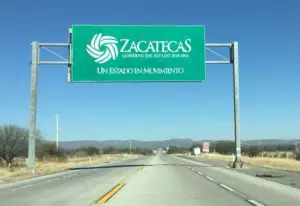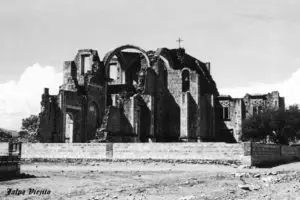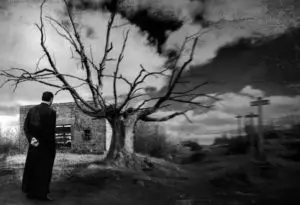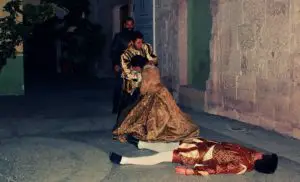Podcast: Play in new window | Download
Subscribe: Apple Podcasts | RSS
 The State of Zacatecas is located in north-central Mexico and borders 8 other states. The Spanish first arrived in the area in the early 1530s and found it rich in natural resources. The state is home to beautiful mountains, stunning colonial architecture and many legends. Here are 4.
The State of Zacatecas is located in north-central Mexico and borders 8 other states. The Spanish first arrived in the area in the early 1530s and found it rich in natural resources. The state is home to beautiful mountains, stunning colonial architecture and many legends. Here are 4.
- The Black Monolith of Death
In colonial times two friends – Misael Galán and Gildardo Higinio – explored the mountains of what is now Zacatecas with the sole objective of getting rich. Misael and Gildardo spent a lot of time in the great open spaces of this new land, enduring all kinds of inclement weather and deprivation, getting to know the mountains, which were rumored to hide treasures that would make them wealthy. Finally, after many months of searching, Misael and Gildardo found a strange cave that housed a black, shiny cubic-shaped stone inside. Both friends assumed that the item was of great value although they could not tell what it was or who might have fashioned its sleek and straight-cut surfaces. With great work, they removed it from the ground and set out to haul it back to town. They intended to break it into several pieces and sell it off. The news that the two boys had finally found something of incredible value in the mountains had somehow reached the town. The neighbors prepared to receive them with a party, but the days passed and there was no sign of them. Worried, the neighbors prepared to go in search of the pair. They were found at the entrance of the mysterious cavern, dead, with signs of having been attacked with a knife. They all wondered, amidst astonishment, what that scene meant: had the friends made a suicide pact? Had they killed each other blinded by greed? Had they been attacked by bandits? But if so, why should the criminals abandon the valuable black monolith? There was no simple explanation to the mystery, so the villagers loaded the bodies of the boys onto a cart along with the strange stone and returned to the town. Days after the burial, a man, a well-known local merchant who had been in custody of the stone, murdered his wife and then killed himself. The neighbors wondered what could have triggered this tragedy, since both the husband’s and the wife’s overall behaviors were flawless. However, one of the neighbors made a correct observation: in both scenes of violence the common element was the strange black stone. One neighbor theorized that the stone was fabricated as a curse by indigenous shamans who were forced out of their lands when the Spanish arrived. Another thought the stone came straight from the Devil himself. The neighbors decided to get rid of this curious monolith. One group offered to return it to the cave where it belonged. After a few days, as they did not return, the villagers marched in search of them, fearing to find the worst. The villagers’ suspicions were correct: the search party was found dead, in conditions like the two previous cases. It was urgent to get rid of the cursed stone, but no one dared carry it. They finally found the solution through the local priest: the stone was sprinkled with holy water and was transferred, with great care, to a secret place. One rumor says that it can still be seen, from a distance, embedded in a wall of the Zacatecas cathedral, not far from a small brass bell that sounds mysteriously if someone gets too close.
- The Last Confession
Father Martín Esqueda was a classic village priest. As the parish priest of the church of Santo Domingo, in Zacatecas, he spent his days preaching the Gospel to his faithful congregation without any incident. It was the custom of the inhabitants to visit him at any time of the day and night, piously asking for a confession for a man or woman on their deathbed.
 But in the year 1850, an event would change everything he knew up to that moment. Late at night, an old woman came to his door requesting a final confession for a relative of hers who, most likely, would not have survived the dawn. Father Martín agreed without question, because for him it was completely normal to make that kind of confession at home, no matter what time of day. He collected his conventional religious instruments: the bible, a rosary and his characteristic stole to be draped over his shoulders as is the custom.
But in the year 1850, an event would change everything he knew up to that moment. Late at night, an old woman came to his door requesting a final confession for a relative of hers who, most likely, would not have survived the dawn. Father Martín agreed without question, because for him it was completely normal to make that kind of confession at home, no matter what time of day. He collected his conventional religious instruments: the bible, a rosary and his characteristic stole to be draped over his shoulders as is the custom.
Together with the old woman, he began the journey on foot to the vicinity of the Plaza de Toros. Behind the plaza there was a group of very old houses that had been deteriorated by the passage of time. She opened one of these houses for him until she reached a very small room where a man was resting, clearly weak and ill.
At the same moment that the father entered the small room, the old woman turned around and without saying a single word, she left. Father Martín practiced his usual confession ritual without any irregularity. He returned home and thus ended his night.
The next day, the father noticed that something very important was missing: he had forgotten his stole in that old house. He decided to send two volunteers from his church to retrieve it, but both returned unsuccessfully to the padre. No one in the sick house opened the door for them.
Father Martín decided to go by himself to retrieve the prized stole, but like the people he sent, he did not receive any response from within the house. From a window of a neighboring building, the owner of the dilapidated houses noticed the insistent father knocking on the door. He approached the humble priest and was surprised. Many years had passed since the last time one of those houses was inhabited. The owner decided to open the door to the priest, and the setting was not the same as Father Martín had remembered the night before. However, amidst dust, creeping bugs and cobwebs, the stole lay hanging on the wooden stake where Father Martín had forgotten it.
Shocked by this strange event, the priest could not even offer the Eucharist that day he was so stunned. Later that night, Father Martín fell ill and died after a few years. He was never the same since that last confession.
- The Ghostly Father and the Sacred Hosts
In the southern mountainous part of the state of Zacatecas in the small town of El Tuitán, the locals rejoiced: They finally had a new chapel built where mass could be celebrated. The year was 1900. The closest priest was in the nearby town of Jalpa. The father would officiate the first mass that began at 6:00 in the morning so that meant the priest was ready to leave Jalpa by four o’clock. December 12th was a special day as the residents of El Tuitán were overjoyed that they would celebrate the day dedicated to the Virgin of Guadalupe with a real priest for the first time.  The last hour of the priest’s journey to the remote town was very difficult as the mountain trails were steep. In addition to being weighed down by his holy vestments, the padre was also carrying what Catholics call a ciborium, a lidded chalice-shaped vessel containing the Eucharist for Holy Communion. The ciborium was rather large as it had to contain enough wafers to give communion to parishioners in El Tuitán and three other towns. Because it was so dark so early in the morning, the priest also had to carry a lamp to light his way. Even with the light from the lamp, the father tripped over an exposed tree root and fell to the ground, everything in his hands crashing to earth, including the ciborium full of communion wafers. The priest tried to gather up his precious cargo, but the wafers were scattered over a large area and he was already late.
The last hour of the priest’s journey to the remote town was very difficult as the mountain trails were steep. In addition to being weighed down by his holy vestments, the padre was also carrying what Catholics call a ciborium, a lidded chalice-shaped vessel containing the Eucharist for Holy Communion. The ciborium was rather large as it had to contain enough wafers to give communion to parishioners in El Tuitán and three other towns. Because it was so dark so early in the morning, the priest also had to carry a lamp to light his way. Even with the light from the lamp, the father tripped over an exposed tree root and fell to the ground, everything in his hands crashing to earth, including the ciborium full of communion wafers. The priest tried to gather up his precious cargo, but the wafers were scattered over a large area and he was already late.
As time passed, the priest in question moved to another place, became old and died. When he reached heaven, Saint Peter was waiting for him, and told the priest that he had a pending debt on earth. The father with all humility replied that he had been a good priest and had never broken his vows. Saint Peter insisted and reminded the priest about the accident he had on the steep mountain road leading to El Tuitán and the spilling of the hosts. As it is sacrilegious to throw away communion wafers, for penance Saint Peter told the father to go back down to earth to look for the sacred hosts he had lost. Once he found them, Peter promised, then heaven would be his home. Since that time the priest has been suffering, traveling up and down the steep mountain path with his lantern looking for the communion wafers that he cannot seem to find. For well over 100 years now the people of Jalpa and El Tuitán see a little light that goes up and down the steep mountainous trails at night. Surely it is the priest looking for the sacred hosts. They say that there is a solution to save the soul of the priest. Groups of locals must walk the trails at 12 midnight, to look for the lost wafers and thus pay the priest’s penalty for him. One day the missing hosts will be found, and Saint Peter will allow the priest to enter Heaven.
- The Street of the Three Crosses
It was the year 1763. Don Diego de Gallinar was a man attached to tradition. He lived with his niece, Beatriz Moncada, a very beautiful young woman who arrived at her uncle’s house after having lost her parents. Because of her beauty and youth, she was the focus of attention on Tres Cruces Street and beyond.
But not just any suitor was capable of captivating her, only a young indigenous man named Gabriel, whom she had met at a local festival. Inspired by the purest love, Gabriel serenaded her every night, while Beatriz religiously sat on her balcony and listened.
 Don Diego, far from believing in romantic notions, had imposed on his niece an arranged marriage with his son, Antonio de Gallinar, who longed for the moment to consummate the alliance with the most desired young woman in the city of Zacatecas.
Don Diego, far from believing in romantic notions, had imposed on his niece an arranged marriage with his son, Antonio de Gallinar, who longed for the moment to consummate the alliance with the most desired young woman in the city of Zacatecas.
One night, Don Diego discovered young Gabriel’s nocturnal serenades and forced him to leave expressing the utmost authority and aggressiveness. The young indigenous man responded firmly that he would be leaving out of commitment and respect, but not out of fear of Don Diego’s violence.
The uncle, feeling afflicted and challenged, attacked Gabriel with his fancy sword, and during the struggle he ended up mortally wounded with his own weapon. Suddenly Gabriel, still confused by the terrifying scene, felt a deep stab in the back.
A servant of Don Diego who, seeing the young indigenous man distracted, murdered him in cold blood in the most vile and cowardly way, taking revenge for his boss. Beatriz could not bear to see this terrible scene, so she fainted and fell from the balcony, ironically landing right on top of the two other bodies. The impact of the fall took her life instantly and this is how Calle de las Tres Cruces, or Street of the Three Crosses, got its name.
REFERENCES
Para todo Mexico website (in Spanish)
